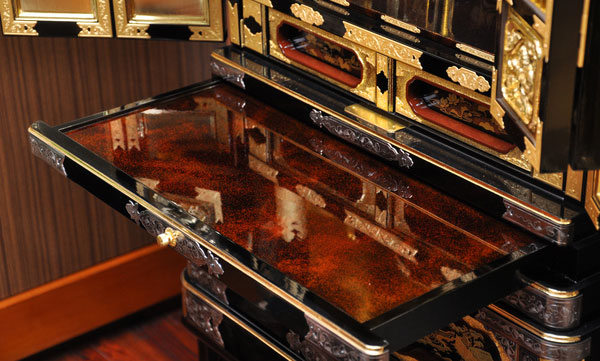 Photo:Niigata Prefecture
Photo:Niigata Prefecture
- Household Buddhist altars
- Niigata
Sanjo Buddhist altar Sanjo butsudan
An aura of magnificence and grace
Subtle, profound and traditional art
Description
What is Sanjo Buddhist altar ?
Sanjo Butsudan are Buddhist altars made in the Sanjo area, Niigata prefecture. They are golden altars with well-established characteristics of elegance and dignity. Sanjo Butsudan is characterized by the orthodox design of an inner sanctuary, quality handcrafted metal ornaments and exquisite urushi lacquering. The inner sanctuary design called kuden-zukuri is imitative of temple architecture, and Sanjo Butsudan are designed after the head or branch temples. Prospering as the hub of hardware industry, Sanjo City made use of their honed techniques to produce ornamental fine metal for altars, delivering metal ornaments peerless in finished quality. Sanjo Butsudan adheres to the orthodox design of an inner sanctuary as with Kyo Butsudan, adopting the hozogumi assembly where wooden base parts are tenoned without nails, and the beam running between the columns called nageshi are either yumigata nageshi, shaped like a bow, or warabigata nageshi, shaped like a bracken. The masugumi (square framing) or hijiki masugumi (square framing using bracket arms) technique is used in building the inner sanctuary.
History
The Sanjo area, also known as "The capital of Buddhisim" has always been strongly associated with Buddhism. Once renowned for hardware production during the early Edo Period, Sanjo transformed itself into the center of Buddhist altar production in the mid-Edo Period following the aggressive construction of large temples. Honjo-ji Temple was built as the grand head temple of the Hokke sect in 1299, and especially the building in 1690 of the Sanjo Betsuin (branch temple) of the Shinshu sect Otani School, known as Higashi Betsuin, drove the city into brisk altar production. A number of local artisans from Sanjo were engaged in the construction of Sanjo Betsuin under the guidance of carpenters specialized in building shrines and temples summoned from Kyoto. After this, the Jodo Shinshu sect became widespread, and production of Buddhist altars started. The Shinano River enabling smooth transportation of raw materials was another reason why altar production moved into high gear.
General Production Process
- 1. Wooden base This process is building the wooden base of a Buddhist altar. Carefully selected wooden pieces are tenoned. This is a technique where a tenon is inserted into a corresponding mortise hole to joint the parts together with no nails. Assembling the base without nails results in a beautiful appearance as well as high strength.
- 2. Inner sanctuary This process is building the inner sanctuary, which is a miniature shrine where a Buddha statue is enshrined. The masugumi (square framing) or hijiki masugumi (square framing using bracket arms) technique is used to build the inner sanctuary. The inner sanctuary of Sanjo Butsudan are designed after temples as closely as possible.
- 3. Wood sculpture This process is delicate wood decor carving according to sect-designated designs, using different kinds of chisels and knives.
- 4. Ornamental fine metal This process is handcrafting metal ornaments for Buddhist altars. Exquisite patterns are engraved in a copper or copper alloy sheet using a chisel.
- 5. Urushi lacquering Urushi lacquering is painting the wooden base with natural urushi lacquer. Traditional Urushi lacquering techniques include nuritate, nashiji-nuri, and mokumedashi-nuri. Nuritate is a technique of repeatedly painting the surface with urushi without whetting, providing a soft texture unique to urushi work. Nashiji-nuri is a technique of finishing the urushi-lacquered surface with gold or silver powder. The naming is derived from the finished surface resembling the skin of a pear, nashi in Japanese. Mokumedashi-nuri is a technique of coating urushi lacquer to enhance the grain effect of wood. Each technique adds its unique flavor to the finish.
- 6. Maki-e Maki-e is a technique of drawing exquisite patterns or designs on the urushi-painted surface using refined urushi lacquer, with gold or silver powder sprinkled. Sanjo Butsudan adopts hira maki-e and sabiage maki-e techniques for decors. Hira maki-e is known as a basic technique that involves drawing a pattern with urushi lacquer, sprinkling gold powder over it, and coating it with clear urushi lacquer. Sabiage maki-e is a type of taka maki-e technique which creates a three dimensional design that requires coating the surface with rust lacquer mixed with polishing powder.
- 7. Gilding Gilding is an important process to decorate the altar with pure gold leaf, adding grace and distinction. There are three gilding techniques; hikari-oshi, tsuyakeshi-oshi, and nugui. Hikari-oshi (burnishing) and tsuyakeshi-oshi (matting) are used for Sanjo Butsudan. Hikari-oshi gives the gold-leafed surface a mirror-smooth gloss finish, while tsuyakeshi-oshi delivers a matte effect to the surface. The same gold leaf is used, but the surface finish varies with the type of paints coated on the surface before gilding.
- 8. Assembly Assembly is the final process of the Buddhist altar production. The parts are checked thoroughly for any dimension errors and inadequate finish in gilding and urushi lacquering, and they are adjusted as needed. All the checked parts are assembled to complete one altar.
See more Household Buddhist altars
- Osaka Buddhist altar
- Hikone Buddhist altar
- Iiyama Buddhist altar
- Nagoya Buddhist altar
- Kanazawa Buddhist altar
- Kawanabe Buddhist altar
- Kyo Buddhist altar
- Hiroshima Buddhist altar
- Mikawa Buddhist altar
- Kyo Buddhist altar equipment
- Nanao Buddhist altar
- Yamagata Buddhist altar
- Yame-fukushima Buddhist altar
- Nagaoka Buddhist altar
- Sanjo Buddhist altar
- Niigata-shirone Buddhist altar
- Owari Buddhist altar equipment
See items made in Niigata
- Ojiya chijimi textiles
- Shiozawa tsumugi silk
- Hon-shiozawa silk
- Ojiya tsumugi silk
- Niigata lacquerware
- Kamo traditional chest
- Murakami carved lacquerware
- Tsubame-tsuiki copperware
- Echigo-sanjo cutlery
- Tokamachi traditional resist-dyed textiles
- Nagaoka Buddhist altar
- Tokamachi akashi chijimi textiles
- Echigo-yoita cutlery
- Sanjo Buddhist altar
- Niigata-shirone Buddhist altar































































































































































































































































































